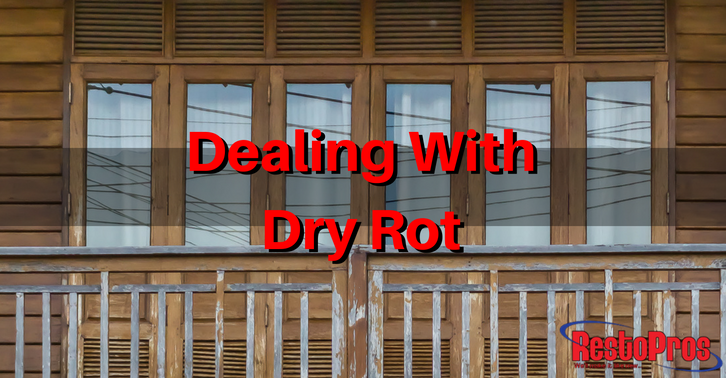 The wood in your home has been treated, varnished, and protected before installation. This leaves you with a material that is strong, relatively inexpensive, and very resistant to most kinds of biological attacks or fungal growths. That doesn’t mean your home is completely immune just because it’s made from wood. You may have heard about dry rot, a fungus that breaks down wood over time. Despite the name, dry rot forms when the moisture content of the wood in your home is raised above a certain level. Prolonged humidity or water contact will cause moisture to seep into wood and allow for dry rot to settle in. While today’s homes are designed to prevent this from happening, the system isn’t perfect and a lack of maintenance can lead to higher than normal moisture levels and weakening timbers.
The wood in your home has been treated, varnished, and protected before installation. This leaves you with a material that is strong, relatively inexpensive, and very resistant to most kinds of biological attacks or fungal growths. That doesn’t mean your home is completely immune just because it’s made from wood. You may have heard about dry rot, a fungus that breaks down wood over time. Despite the name, dry rot forms when the moisture content of the wood in your home is raised above a certain level. Prolonged humidity or water contact will cause moisture to seep into wood and allow for dry rot to settle in. While today’s homes are designed to prevent this from happening, the system isn’t perfect and a lack of maintenance can lead to higher than normal moisture levels and weakening timbers.
Types of Rot
While similar to other types of rotting, wood rot is exclusively due to a fungal growth that breaks down the cellular structure of wood, waking timbers and leading to possible structural collapse. There two types of wood rot you’ll find are brown and white rot.
Brown Rot cracks across the grain of timbers while simultaneously darkening the wood’s color. After enough time has past, the wood will take on a dry feeling that crumbles to dust.
White Rot lightens the color of the wood without any cross cracking. The wood takes on a stringy texture as the fibers loosen from each other.
Another way to break down the differences in wood rot is the different between dry and wet rots. Wet rots are the most common but dry rot (a type of brown rot) is often the most devastating and likely more difficult to deal with. Dry rots set into wood but they can crawl across other surfaces, moving behind plaster, wallpapers, or over brick to reach more wood in your home. They’re more difficult to remove because they can remain hidden in harder to find areas. The first thing a professional does is analyze whether the rot is a dry or wet type, then increase the inspection area to find anywhere else the rot as spread to.
How to Find Dry Rot
If you’re worried about or suspect dry rot, stay on the lookout for:
- Shrinking wood that darkens and cracks in a ‘cuboidal’ manner
- A silky grey to mushroom colored skin frequently tinged with patches of lilac and yellow. This often develops under less humid conditions. The ‘skin’ can be peeled like a mushroom.
- White, fluffy ‘cottonwool’ mycelium develops under humid conditions. ‘Teardrops’ may develop on the growth.
- Strands develop in the mycelium; these are brittle and when dry and crack when bent.
- Fruiting bodies are a soft, fleshy pancake or bracket with an orange-ochre surface. The surface has wide pores.
- Rust red colored spore dust frequently seen around fruiting bodies.
- Active decay produces a musty, damp odor.
The best way to deal with dry rot is to call a professional treatment company. You’ll need to remove the moisture source (dripping pipes, leaking roof, etc) to make sure the issue doesn’t reoccur later. All affected timbers and materials will need to be remove and replaced. Porous woods are going to house the spores for dry rot and it will be incredibly difficult to treat without replacing. Remaining surfaces will need to be cleaning with a fungicide.
Don’t forget to follow RestoPros on Facebook, Twitter, LinkedIn, and Google+ for new Updates, News, and Discounts
